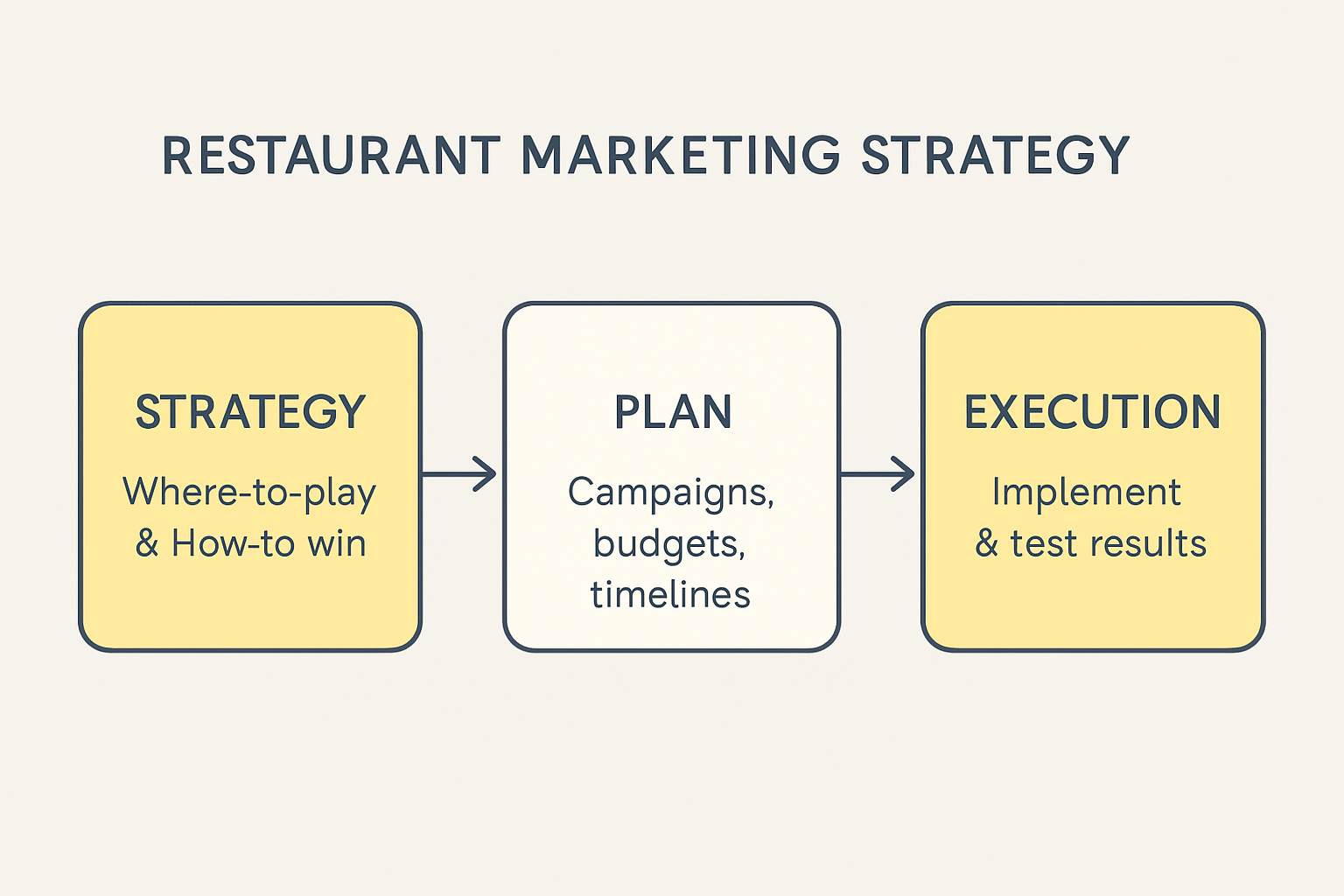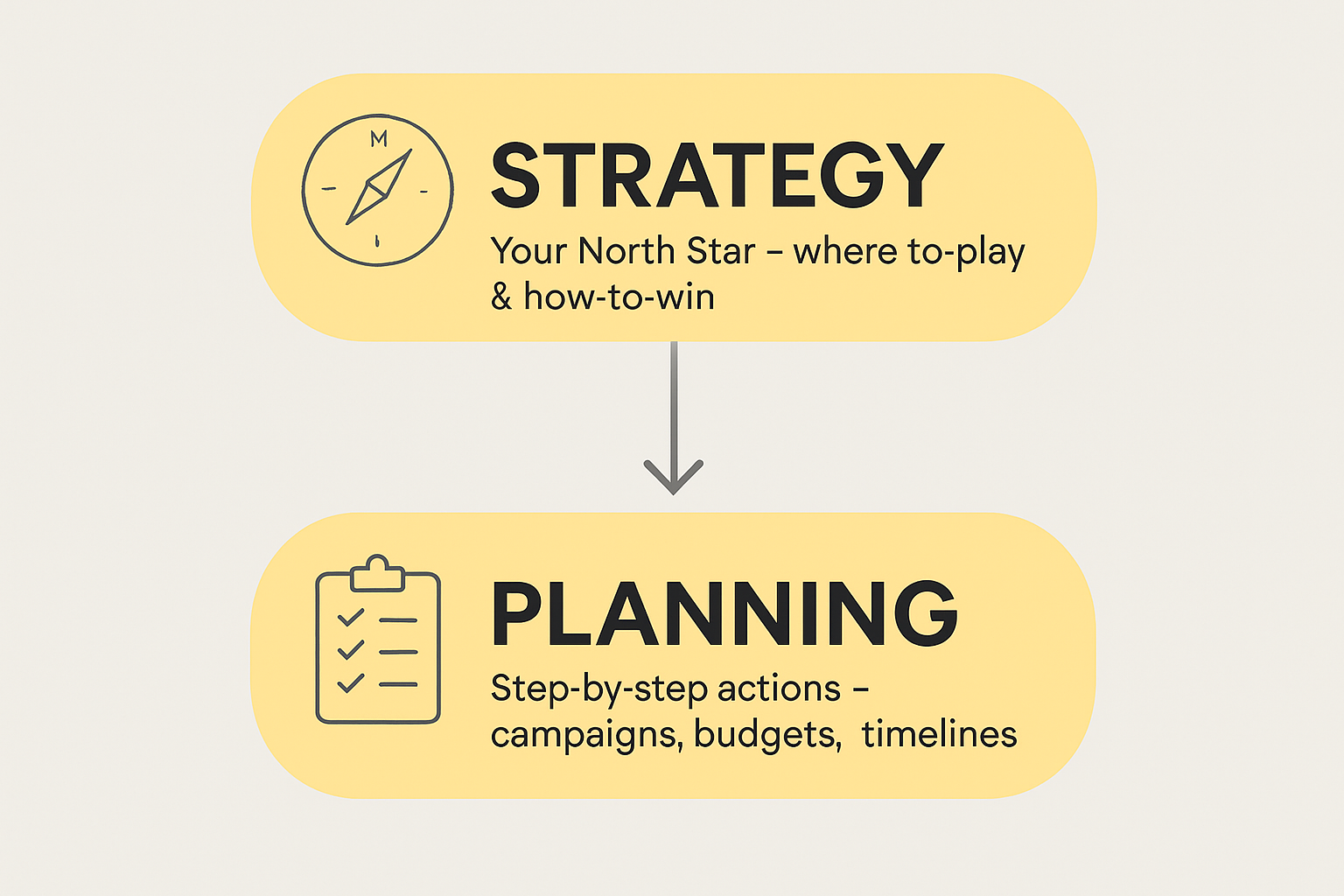Restaurant Marketing Strategies: Ideas, Tips, and Best Practices
Thamyn Naidoo
This article was prepared by Gourmet Marketing, a restaurant marketing agency specializing in restaurant strategy, digital marketing, and growth solutions.
Why Restaurant Marketing in 2026 Looks Different
Running a restaurant in 2026? Well, it’s not just about serving amazing food anymore. Your competition isn’t just the place down the street; it’s ghost kitchens popping up online, viral pop-ups on TikTok, and delivery apps popping notifications straight into your customers’ pockets.
If you’ve ever felt overwhelmed trying to keep up, you’re not alone. The truth is, having a clear restaurant marketing strategy can feel tricky, but it’s exactly what makes all the difference. Here’s the simple idea: your strategy is your compass; it tells you where to go and how to stand out. Your plan? That’s the step-by-step map to actually get there.
In this guide, we’re going to break it down in plain, no-jargon terms. We’ll cover everything from modern restaurant marketing ideas to digital tools and show you how to put together restaurant marketing strategies that actually work in 2026. Think of it as your friendly roadmap to not just surviving but thriving in the modern restaurant world.
Strategy vs. Plan—The Foundation

Think of strategy as your map and planning as your route. Strategy answers the big questions: who are your customers, where will you compete, and what gives you an edge? Planning answers the tactical questions: which campaigns, channels, and budgets will get you there.
According to Roger L. Martin, strategy is broken down into two pieces:
- Where-to-Play: This is your market. Are you targeting local foot traffic, delivery-only customers, or a mix? Are you focusing on families, young professionals, or niche diners who crave experimental flavors?
- How-to-Win: This is your competitive advantage. Maybe your restaurant offers the fastest delivery in the neighborhood, a unique subscription tasting menu, or a sustainability-first dining experience. Whatever it is, it needs to be tangible, lasting, and relevant to your customers.
Once your strategy is clear, your marketing plans for restaurants fall naturally into place (Roger L. Martin).
The Best Marketing Strategies for Restaurants in 2026
So what does a winning restaurant marketing strategy look like in today’s world? Here are a few core pillars that are shaping success:
1. Differentiation Through Digital Experience
Your customers expect seamless digital interactions. Mobile ordering, QR menus, and integrated loyalty apps aren’t just “nice to have”; they’re expected. Restaurants that make it effortless for diners to browse, order, and pay digitally gain a real advantage. This is where your digital marketing strategy for restaurants comes into play.
2. Brand Storytelling & Content Marketing
Social media and content creation have evolved. It’s not enough to post a menu; diners want to know who’s behind the food. Share your chef’s story, behind-the-scenes prep, or a day in the life at your kitchen. Platforms like TikTok, Instagram, and even AI-driven video tools let you tell these stories in ways that feel authentic (MASV). This is a modern example of restaurant marketing best practices, using content to build loyalty and engagement.
3. Sustainability & Mission-Driven Branding
More diners are making choices based on values. Sourcing locally, reducing waste, and highlighting eco-friendly practices can give you a lasting advantage. This isn’t a trend, it’s part of your restaurant marketing strategy that can differentiate your brand from competitors.
Restaurant Marketing Ideas That Actually Work
Now for the fun part: ideas that bring your strategy to life. Here are some actionable restaurant marketing ideas for 2026:
- AR Menus and Immersive Dining Experiences – Let diners explore dishes in augmented reality or host interactive tasting events.
- Viral Recipe Drops – Short-form videos highlighting unique recipes or behind-the-scenes kitchen prep.
- Limited-Time Flavor Experiments – Test seasonal or trend-inspired dishes to create a hype.
- Subscription & Loyalty Programs – Monthly chef’s boxes, wine clubs, or exclusive tasting menus.
- Hyperlocal Influencer Partnerships – Collaborate with neighborhood influencers to drive foot traffic or online orders.
These examples show how restaurant marketing ideas can directly connect to your “where-to-play” audience and your “how-to-win” advantage.
Digital Marketing for Restaurants—The Non-Negotiables
Digital isn’t optional anymore; it’s your main stage. Here are the essential elements of digital marketing for restaurants:
- Local SEO & “Near Me” Optimization – Make sure your Google Business Profile is up to date, with accurate hours, photos, and menus. Many diners search “restaurants near me” before making a decision.
- Social Media Storytelling – Use platforms to highlight your food, your brand, and your team in a way that resonates with your target customers.
- Email & SMS Marketing – First-party data is gold. Collect emails and phone numbers to promote specials, events, or loyalty perks directly.
- Paid Advertising – Geo-targeted and retargeted ads can boost visibility for local diners and delivery customers.
Integrating these into your digital marketing strategy for restaurants ensures every campaign works toward your overarching strategy.
Restaurant Marketing Best Practices (2026 Edition)
To tie it all together, here are some updated restaurant marketing best practices:
- Test, Measure, Adapt – Plans may fail; strategies should remain constant. Use A/B testing for offers, content, and campaigns.
- Consistency Across Channels – Your branding and messaging should feel seamless, whether online, in-app, or in person.
- Balance Innovation with Reliability – Experiment with new tech or flavors, but deliver consistently on your core promise.
Following these practices ensures your marketing strategies for restaurants are not just clever but effective.
Bringing Strategy and Planning Together

Here’s the key takeaway: your strategy is your north star; your plan is the journey. Even in a fast-changing landscape of AI tools, ghost kitchens, and viral content, the combination of a clear strategy plus actionable plans is what drives revenue and customer loyalty (Harvard University).
- Strategy = your overarching advantage and target audience.
- Plan = campaigns, budgets, timelines, and testing methods.
By keeping your restaurant marketing strategies aligned with execution, you’ll always know which actions move the needle.
Future-Proof Your Restaurant Marketing
The restaurants that thrive in 2026 and beyond will be those that treat strategy as ongoing, not one-and-done. AI personalization, immersive dining experiences, predictive menus, and evolving social platforms are only going to become more important.
Remember: your strategy gives you clarity, your plan gives you action, and together they future-proof your restaurant marketing. Using these approaches, your restaurant can stay ahead of competitors, delight your customers, and keep growing, no matter what 2026 brings.